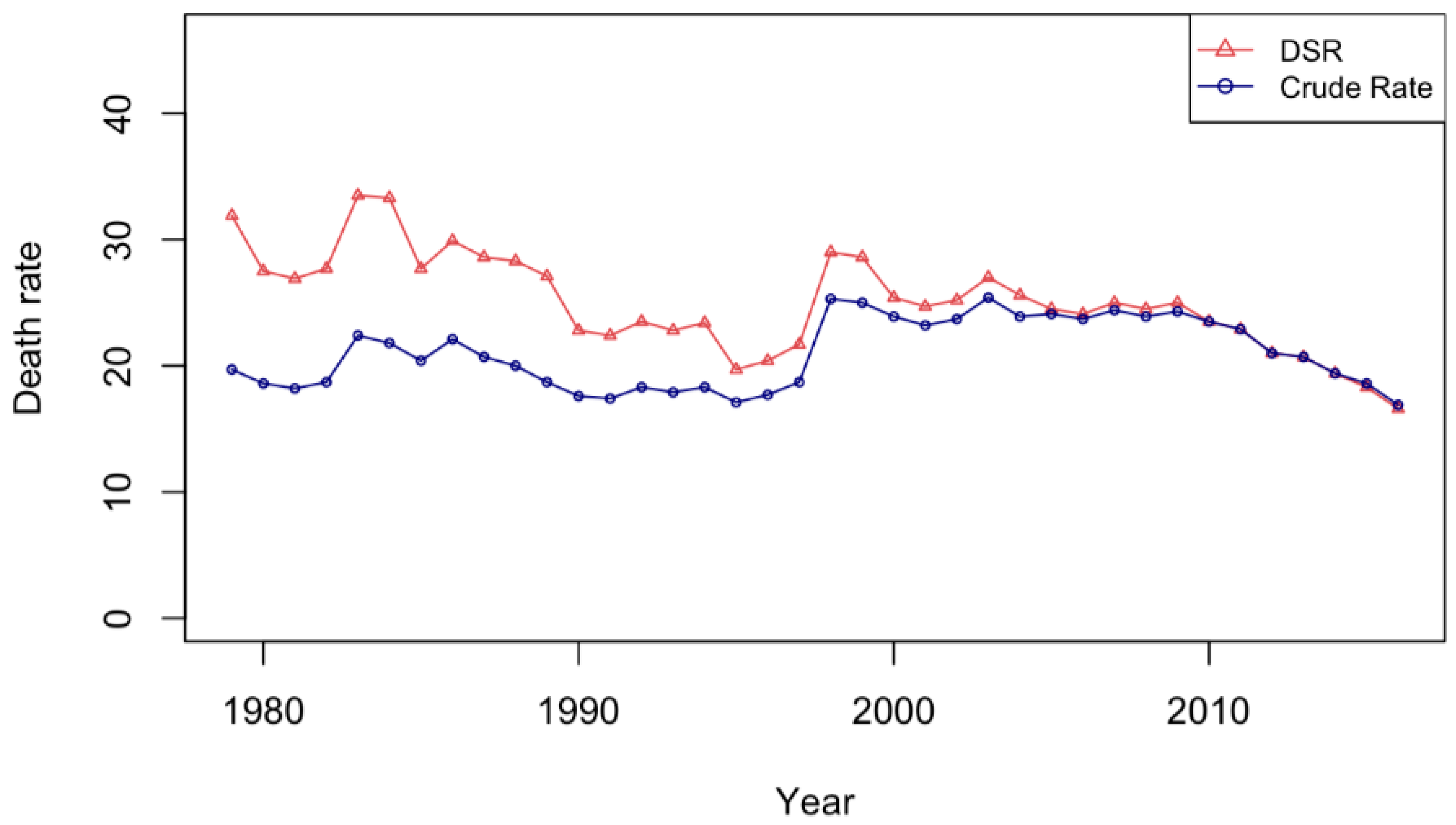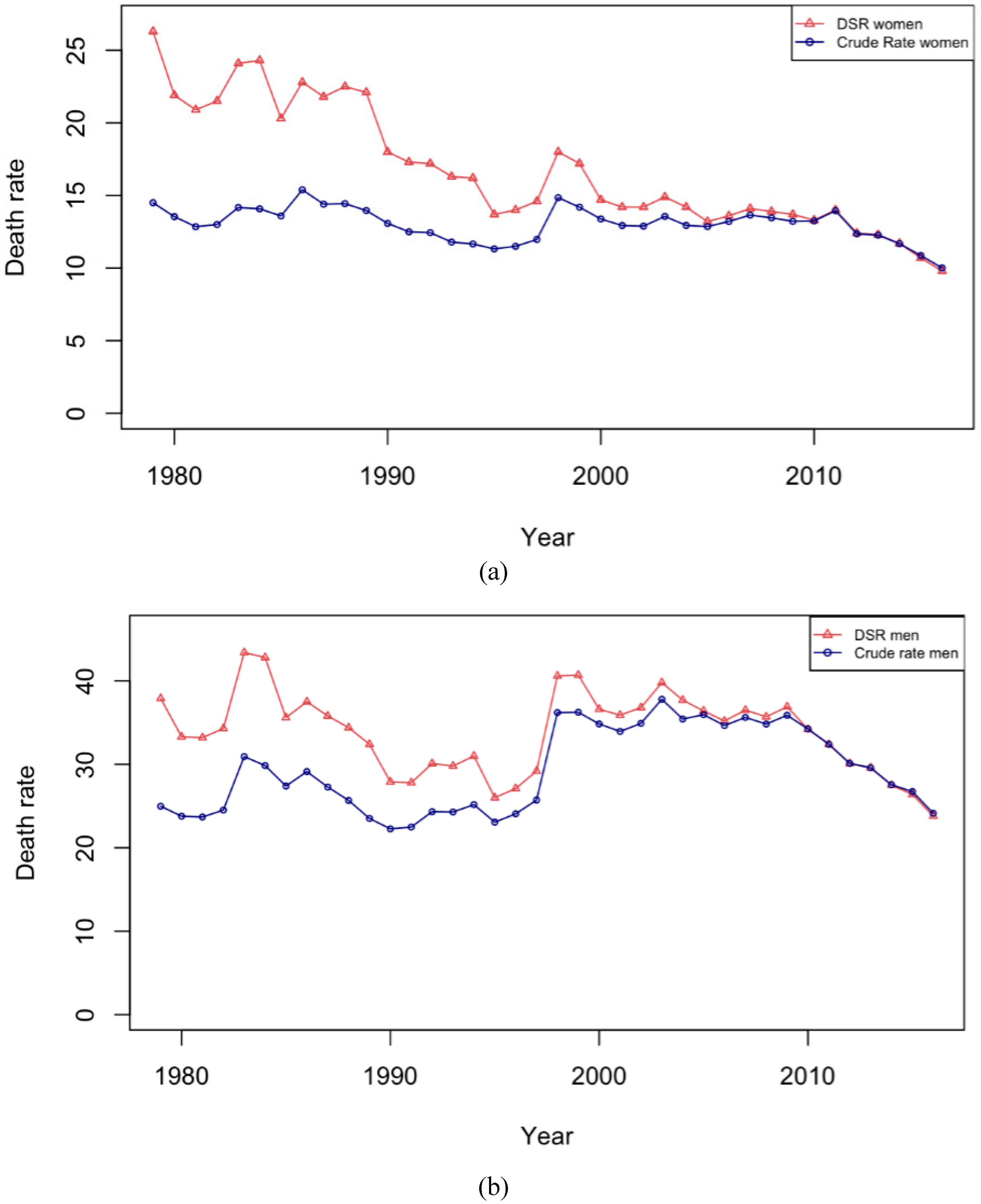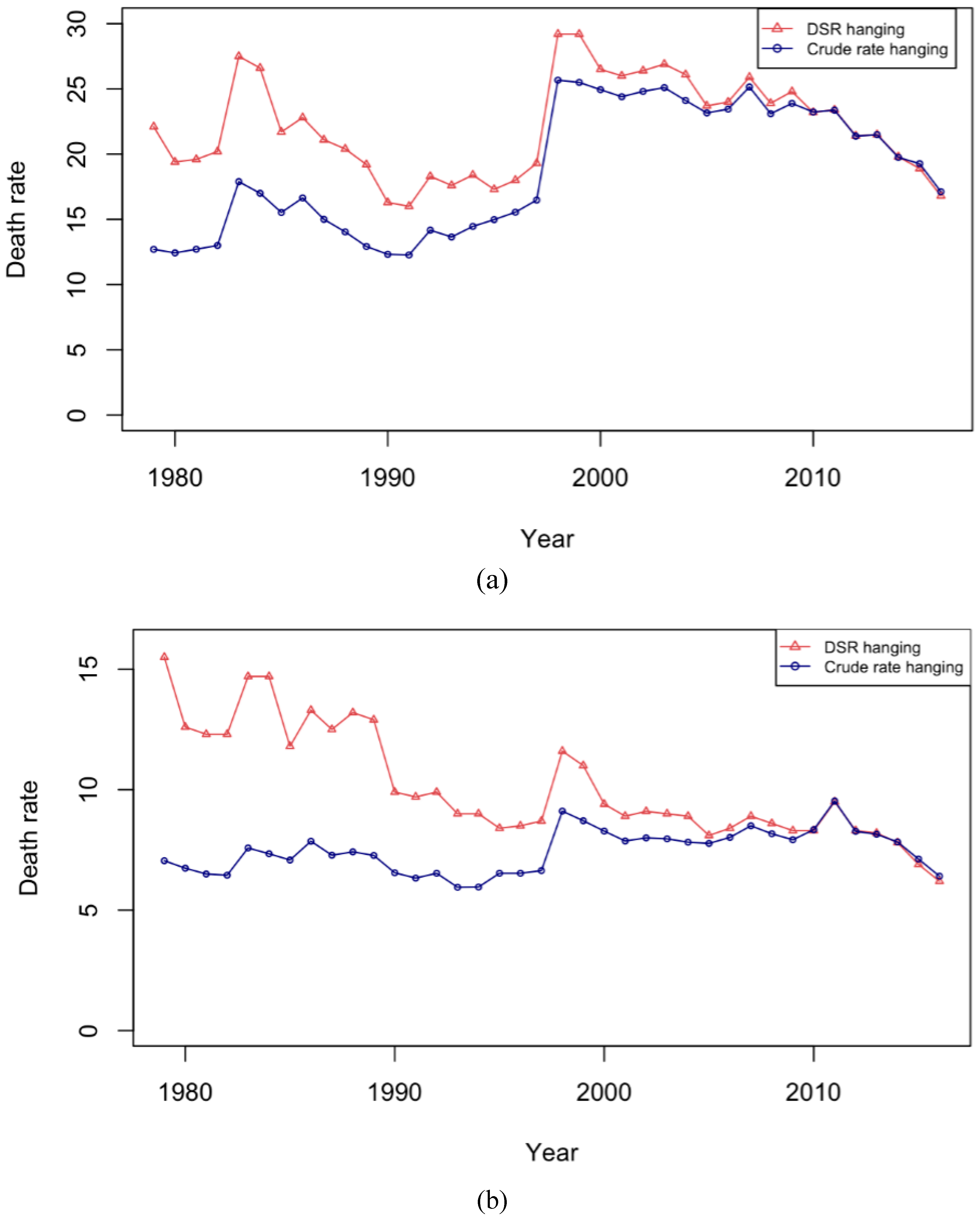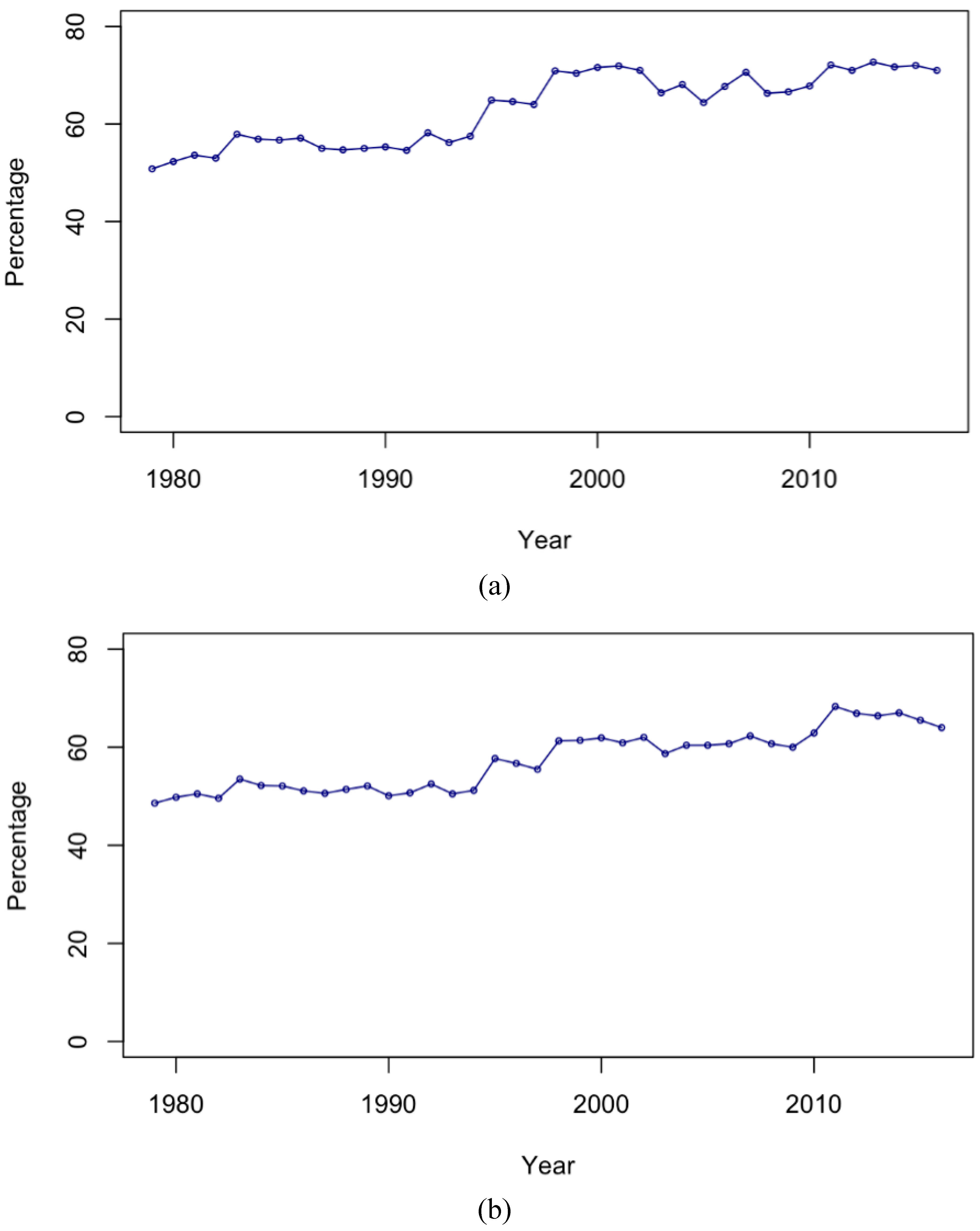Trends in Suicide Mortality by Method from 1979 to 2016 in Japan
Abstract
1. Introduction
- Characterize the trends in and risk factors for suicide in Japan
- Assess the role of aging in the increase in suicide rates in 1998
- Identify the magnitude of the increase in 1998 and the extent to which it is driven by changes in method
2. Materials and Methods
3. Results
Trends in and Risk Factors for Suicide in Japan
4. Discussion
5. Conclusions
Supplementary Materials
Author Contributions
Funding
Conflicts of Interest
References
- World Health Organization. Suicide Rates (per 100,000 Population). Global Health Observatory; WHO: Geneva, Switzerland, 2016. [Google Scholar]
- Pompili, M.; Venturini, P.; Lamis, D.A.; Giordano, G.; Serafini, G.; Belvederi Murri, M.; Amore, M.; Girardi, P. Suicide in stroke survivors: Epidemiology and prevention. Drugs Aging 2015, 32, 21–29. [Google Scholar] [CrossRef] [PubMed]
- World Health Organization. Preventing Suicide: A Global Imperative; WHO Libr. Cat. Data; WHO: Geneva, Switzerland, 2014. [Google Scholar]
- World Health Organization. Japan Turning a Corner in Suicide Prevention; WHO: Geneva, Switzerland, 2015. [Google Scholar]
- United Nations Population Division. Suicide Rate by Country. World Population Prospects; UN: New York, NY, USA, 2017. [Google Scholar]
- Ministry of Health, Labour and Welfare Japan. Vital Statistics of Japan, Statistics & Information Department, Minister’s Secretariat 1975–2016; MHLW: Tokyo, Japan, 2016.
- Ojima, T.; Nakamura, Y.; Detels, R. Comparative study about methods of suicide between Japan and the United States. J. Epidemiol. 2004, 14, 187–192. [Google Scholar] [CrossRef]
- Ootsu, T.; Shuto, K.; Murayama, R. Suicide deaths in Japan: Analyses of suicide methods. In WHO-Family of International Classifications Network Meeting; WHO: Geneva, Switzerland, 2005; pp. 16–22. [Google Scholar]
- Yoshioka, E.; Saijo, Y.; Kawachi, I. An analysis of secular trends in method-specific suicides in Japan, 1950–1975. Popul. Health Metr. 2017, 15, 14. [Google Scholar] [CrossRef][Green Version]
- Yoshioka, E.; Hanley, S.J.; Kawanishi, Y.; Saijo, Y. Time trends in method-specific suicide rates in Japan, 1990--2011. Epidemiol. Psychiatr. Sci. 2016, 25, 58–68. [Google Scholar] [CrossRef]
- Yunus, S. Methods and Causes of Suicide: A comparative Study between India and japan. In Proceedings of the 87th Symposium of the Japan Sociological Society, Kobe, Japan, 23 November 2014. [Google Scholar]
- Kim, S.Y.; Kim, M.-H.; Kawachi, I.; Cho, Y. Comparative epidemiology of suicide in South Korea and Japan: Effects of age, gender and suicide methods. Crisis 2011, 32, 5–14. [Google Scholar] [CrossRef]
- Takahashi, Y. Suicide in Japan: What Are the Problems? In Suicide Prevention: The Global Context; Kosky, R.J., Eshkevari, H.S., Goldney, R.D., Eds.; Plenum Press: New York, NY, USA, 1998. [Google Scholar]
- Elnour, A.A.; Harrison, J. Lethality of suicide methods. Inj. Prev. 2008, 14, 39–45. [Google Scholar] [CrossRef]
- Yoshioka, E.; Hanley, S.J.B.; Kawanishi, Y.; Saijo, Y. Epidemic of charcoal burning suicide in Japan. Br. J. Psychiatry 2014, 204, 274–282. [Google Scholar] [CrossRef] [PubMed]
- Park, S.; Ahn, M.H.; Lee, A.; Hong, J.P. Associations between changes in the pattern of suicide methods and rates in Korea, the US, and Finland. Int. J. Ment. Health Syst. 2014, 8, 22. [Google Scholar] [CrossRef] [PubMed][Green Version]
- Cantor, C.H.; Baume, P.J.M. Access to methods of suicide: What impact? Aust. N. Z. J. Psychiatry 1998, 32, 8–14. [Google Scholar] [CrossRef]
- Hawton, K. Restriction of access to methods of suicide as a means of suicide prevention. In Prevention and Treatment of Suicidal Behaviour from Science to Practice; Oxford University Press: Oxford, UK, 2005; pp. 279–291. [Google Scholar]
- Hawton, K. Restricting access to methods of suicide: Rationale and evaluation of this approach to suicide prevention. Crisis 2007, 28, 4–9. [Google Scholar] [CrossRef]
- OECD Data. Suicide Rates; OECD: Paris, France, 2016. [Google Scholar]
- Lester, D.; Saito, Y. The reasons for suicide in Japan. OMEGA-J. Death Dying 1999, 38, 65–68. [Google Scholar] [CrossRef]
- Yamamura, T.; Kinoshita, H.; Nishiguchi, M.; Hishida, S. A perspective in epidemiology of suicide in Japan. Vojnosanit. Pregl. 2006, 63, 575–583. [Google Scholar] [CrossRef] [PubMed]
- Lester, D. Domestic integration and suicide in 21 nations, 1950–1985. Int. J. Comp. Sociol. 1994, 35, 131. [Google Scholar] [CrossRef]
- Chaurasia, A.R. Fertility, mortality and age composition effects of population transition in China and India: 1950–2015. Comp. Popul. Stud. 2017, 42. [Google Scholar] [CrossRef]
- Lester, D. Domestic social integration and suicide in Israel. Isr. J. Psychiatry Relat. Sci. 1997, 34, 157–161. [Google Scholar] [PubMed]
- Gilmour, S.; Wattanakamolkul, K.; Sugai, M.K. The Effect of the Australian National Firearms Agreement on Suicide and Homicide Mortality, 1978–2015. Am. J. Public Health 2018, 108, 1511–1516. [Google Scholar] [CrossRef]
- Ahmad, O.B.; Boschi-Pinto, C.; Lopez, A.D.; Murray, C.J.; Lozano, R.; Inoue, M. Age Standardization of Rates: A New WHO Standard; World Health Organization: Geneva, Switzerland, 2001; Volume 9, p. 10. [Google Scholar]
- Yoshioka, E.; Hanley, S.J.B.; Saijo, Y. Time trends in suicide rates by domestic gas or car exhaust gas inhalation in Japan, 1968–1994. Epidemiol. Psychiatr. Sci. 2018. [Google Scholar] [CrossRef]
- Chang, S.-S.; Gunnell, D.; Sterne, J.A.C.; Lu, T.-H.; Cheng, A.T.A. Was the economic crisis 1997–1998 responsible for rising suicide rates in East/Southeast Asia? A time–trend analysis for Japan, Hong Kong, South Korea, Taiwan, Singapore and Thailand. Soc. Sci. Med. 2009, 68, 1322–1331. [Google Scholar] [CrossRef]
- Chen, J.; Choi, Y.C.; Mori, K.; Sawada, Y.; Sugano, S. Recession, unemployment, and suicide in Japan. Jpn. Labor Rev. 2012, 9, 75–92. [Google Scholar]
- Hashimoto, Y.; Takeshima, T. Assessment of social factors of increase in suicide (in Japanese). Summary Report on Research to Promote Preventive Measures based on the Actual Situation of Suicide, FY2004 Ministry of Health, Labour, and Welfare Grant Research; National Institute of Mental Health (NCNP): Tokyo, Japan, 2005; pp. 37–44.
- Sueki, H. Users’ motivations and associated influence of suicide bulletin board systems. Shinrigaku kenkyu Jpn. J. Psychol. 2011, 81, 577–584. [Google Scholar] [CrossRef][Green Version]
- Sueki, H. The effect of suicide-related Internet use on users’ mental health. Crisis 2013, 34, 348–353. [Google Scholar] [CrossRef]
- Sueki, H.; Yonemoto, N.; Takeshima, T.; Inagaki, M. The impact of suicidality-related internet use: A prospective large cohort study with young and middle-aged internet users. PLoS ONE 2014, 9, e94841. [Google Scholar] [CrossRef]
- Wataru, T. Kanzen jisatsu manyuaru [Complete Manual of Suicide]; Ohta: Tokyo, Japan, 1993. [Google Scholar]
- Ohtsu, T. Usage of the. 9 codes of the ICD-10 for Japanese mortality statistics. Acta Med. Okayama 2009, 63, 281–286. [Google Scholar]
- Tøllefsen, I.M.; Hem, E.; Ekeberg, Ø. The reliability of suicide statistics: A systematic review. BMC Psychiatry 2012, 12, 9. [Google Scholar] [CrossRef]
- Fay, M.P.; Tiwari, R.C.; Feuer, E.J.; Zou, Z. Estimating average annual percent change for disease rates without assuming constant change. Biometrics 2006, 62, 847–854. [Google Scholar] [CrossRef]
- Taylor, S.J.; Kingdom, D.; Jenkins, R. How are nations trying to prevent suicide? An analysis of national suicide prevention strategies. Acta Psychiatr. Scand. 1997, 95, 457–463. [Google Scholar] [CrossRef]
- Loftin, C.; McDowall, D.; Wiersema, B.; Cottey, T.J. Effects of restrictive licensing of handguns on homicide and suicide in the District of Columbia. N. Engl. J. Med. 1991, 325, 1615–1620. [Google Scholar] [CrossRef]
- Gagné, M.; Robitaille, Y.; Hamel, D.; St-Laurent, D. Firearms regulation and declining rates of male suicide in Quebec. Inj. Prev. 2010, 16, 247–253. [Google Scholar] [CrossRef]
- Gunnell, D.; Fernando, R.; Hewagama, M.; Priyangika, W.D.D.; Konradsen, F.; Eddleston, M. The impact of pesticide regulations on suicide in Sri Lanka. Int. J. Epidemiol. 2007, 36, 1235–1242. [Google Scholar] [CrossRef]
- Kreitman, N. The coal gas story. United Kingdom suicide rates, 1960–1971. J. Epidemiol. Community Health 1976, 30, 86–93. [Google Scholar] [CrossRef] [PubMed]
- Amos, T.; Appleby, L.; Kiernan, K. Changes in rates of suicide by car exhaust asphyxiation in England and Wales. Psychol. Med. 2001, 31, 935–939. [Google Scholar] [CrossRef] [PubMed]
- Klieve, H.; Barnes, M.; de Leo, D. Controlling firearms use in Australia: Has the 1996 gun law reform produced the decrease in rates of suicide with this method? Soc. Psychiatry Psychiatr. Epidemiol. 2009, 44, 285. [Google Scholar] [CrossRef] [PubMed]
- Bridge, J.A.; Greenhouse, J.B.; Sheftall, A.H.; Fabio, A.; Campo, J.V.; Kelleher, K.J. Changes in suicide rates by hanging and/or suffocation and firearms among young persons aged 10–24 years in the United States: 1992–2006. J. Adolesc. Health 2010, 46, 503–505. [Google Scholar] [CrossRef]
- Knipe, D.W.; Chang, S.S.; Dawson, A.; Eddleston, M.; Konradsen, F.; Metcalfe, C.; Gunnell, D. Suicide prevention through means restriction: Impact of the 2008–2011 pesticide restrictions on suicide in Sri Lanka. PLoS ONE 2017, 12, e0172893. [Google Scholar]
- Daigle, M.S. Suicide prevention through means restriction: Assessing the risk of substitution: A critical review and synthesis. Accid. Anal. Prev. 2005, 37, 625–632. [Google Scholar] [CrossRef]
- Stack, S.; Wasserman, I. Race and method of suicide: Culture and opportunity. Arch. Suicide Res. 2005, 9, 57–68. [Google Scholar] [CrossRef] [PubMed]
- Farmer, R.; Rohde, J. Effect of availability and acceptability of lethal instruments on suicide mortality: An analysis if some international data. Acta Psychiatr. Scand. 1980, 62, 436–445. [Google Scholar] [CrossRef]
- Ho, R.C.M.; Ho, E.C.L.; Tai, B.C.; Ng, W.Y.; Chia, B.H. Elderly Suicide with and without a History of Suicidal Behavior: Implications for Suicide Prevention and Management. Arch. Suicide Res. 2014, 18, 363–375. [Google Scholar] [CrossRef]




| Variables | Odds Ratio | 95% CI | p-Value |
|---|---|---|---|
| Men | |||
| Year | 1.013 | (1.006–1.021) | <0.01 |
| 1998 increase | 1.367 | (1.163–1.608) | <0.01 |
| Women | |||
| Year | 1.013 | (1.008–1.018) | <0.01 |
| 1998 increase | 1.219 | (1.092–1.359) | <0.01 |
| Suicide Category | Before 1998 | After 1998 | ||
|---|---|---|---|---|
| IRR | 95% CI | IRR | 95% CI | |
| Men | ||||
| Age 15–29 | ||||
| Hanging | 0.989 | (0.986–0.991) | 1.012 | (1.010–1.015) |
| Gas | 0.901 | (0.897–0.906) | 1.075 | (1.070–1.080) |
| Drowning | 0.961 | (0.951–0.970) | 0.981 | (0.967–0.995) |
| Poisoning | 0.950 | (0.942–0.959) | 0.955 | (0.944–0.966) |
| Others | 0.988 | (0.985–0.991) | 0.981 | (0.977–0.985) |
| Age 30–59 | ||||
| Hanging | 0.998 | (0.997–1.000) | 0.975 | (0.974–0.976) |
| Gas | 0.957 | (0.954–0.959) | 1.005 | (1.003–1.007) |
| Drowning | 0.988 | (0.983–0.992) | 0.935 | (0.929–0.940) |
| Poisoning | 0.962 | (0.959–0.966) | 0.942 | (0.938–0.947) |
| Others | 0.993 | (0.991–0.995) | 0.962 | (0.960–0.964) |
| Age 60–79 | ||||
| Hanging | 0.987 | (0.985–0.988) | 0.971 | (0.970–0.972) |
| Gas | 0.998 | (0.989–1.006) | 0.984 | (0.979–0.989) |
| Drowning | 0.968 | (0.961–0.975) | 0.968 | (0.961–0.974) |
| Poisoning | 0.985 | (0.980–0.990) | 0.915 | (0.909–0.921) |
| Others | 1.001 | (0.997–1.005) | 0.966 | (0.963–0.969) |
| Age 80+ | ||||
| Hanging | 0.961 | (0.958–0.964) | 0.967 | (0.965–0.970) |
| Gas | 0.896 | (0.864–0.930) | 1.015 | (0.990–1.041) |
| Drowning | 0.921 | (0.907–0.934) | 0.955 | (0.940–0.970) |
| Poisoning | 0.984 | (0.970–0.997) | 0.943 | (0.932–0.954) |
| Others | 0.946 | (0.938–0.954) | 0.958 | (0.951–0.965) |
| Women | ||||
| Age 15–29 | ||||
| Hanging | 0.989 | (0.984–0.993) | 1.015 | (1.012–1.019) |
| Gas | 0.865 | (0.857–0.873) | 1.087 | (1.077–1.096) |
| Drowning | 0.929 | (0.918–0.940) | 0.973 | (0.957–0.990) |
| Poisoning | 0.950 | (0.941–0.959) | 0.993 | (0.983–1.002) |
| Others | 0.996 | (0.993–1.000) | 0.971 | (0.966–0.975) |
| Age 30–59 | ||||
| Hanging | 0.988 | (0.986–0.990) | 1.001 | (0.999–1.003) |
| Gas | 0.905 | (0.899–0.911) | 1.038 | (1.033 –1.043) |
| Drowning | 0.976 | (0.971–0.980) | 0.935 | (0.929–0.941) |
| Poisoning | 0.959 | (0.954–0.963) | 0.976 | (0.971–0.982) |
| Others | 1.005 | (1.002–1.008) | 0.979 | (0.977–0.982) |
| Age 60–79 | ||||
| Hanging | 0.965 | (0.963–0.967) | 0.974 | (0.973–0.976) |
| Gas | 0.883 | (0.870–0.897) | 1.017 | (1.005–1.030) |
| Drowning | 0.949 | (0.944–0.953) | 0.964 | (0.959–0.969) |
| Poisoning | 0.983 | (0.978–0.988) | 0.924 | (0.918–0.930) |
| Others | 0.993 | (0.989–0.998) | 0.976 | (0.972–0.980) |
| Age 80+ | ||||
| Hanging | 0.962 | (0.959–0.965) | 0.944 | (0.942–0.947) |
| Gas | 0.884 | (0.845–0.924) | 1.002 | (0.965–1.040) |
| Drowning | 0.941 | (0.934–0.948) | 0.923 | (0.914–0.931) |
| Poisoning | 1.004 | (0.992–1.016) | 0.928 | (0.918–0.938) |
| Others | 0.969 | (0.959–0.979) | 0.952 | (0.943–0.960) |
| Suicide Category | IRR | 95% CI | Percent Change | 95% CI |
|---|---|---|---|---|
| Men | ||||
| Age 15–29 | ||||
| Hanging | 1.154 | (1.083–1.229) | 15.4 | (8.3–22.9) |
| Gas | 0.099 | (0.087–0.113) | −90.1 | (−91.3–−88.7) |
| Drowning | 0.711 | (0.485–1.042) | −28.9 | (−51.5–−4.2) |
| Poisoning | 1.725 | (1.279–2.325) | 72.5 | (27.9–132.5) |
| Others | 1.268 | (1.144–1.405) | 26.8 | (14.4–40.5) |
| Age 30–59 | ||||
| Hanging | 2.957 | (2.875–3.042) | 195.7 | (187.5–204.2) |
| Gas | 1.004 | (0.945–1.067) | 0.4 | (−5.5–6.7) |
| Drowning | 3.310 | (2.826–3.877) | 231.0 | (182.6–287.7) |
| Poisoning | 1.811 | (1.583–2.072) | 81.1 | (58.3–107.2) |
| Others | 2.301 | (2.170–2.439) | 130.1 | (117.0–143.9) |
| Age 60–79 | ||||
| Hanging | 2.221 | (2.136–2.309) | 122.1 | (113.6–130.9) |
| Gas | 2.891 | (2.463–3.393) | 189.1 | (146.3–239.3) |
| Drowning | 1.308 | (1.071–1.597) | 30.8 | (7.1–59.7) |
| Poisoning | 3.911 | (3.289–4.650) | 291.1 | (228.9–365.0) |
| Others | 2.384 | (2.167–2.622) | 138.4 | (116.7–162.2) |
| Age 80+ | ||||
| Hanging | 1.109 | (1.021–1.203) | 10.9 | (2.1–20.3) |
| Gas | 0.238 | (0.108–0.526) | −76.2 | (−89.2–−47.4) |
| Drowning | 0.607 | (0.388–0.951) | −39.3 | (−61.2–−4.9) |
| Poisoning | 2.267 | (1.604–3.204) | 126.7 | (60.4–220.4) |
| Others | 0.987 | (0.783–1.245) | −1.3 | (−21.7–−24.5) |
| Women | ||||
| Age 15–29 | ||||
| Hanging | 1.277 | (1.146–1.422) | 27.7 | (14.6–42.2) |
| Gas | 0.044 | (0.034–0.058) | −95.6 | (−96.6–−94.2) |
| Drowning | 0.627 | (0.397–0.988) | −37.3 | (−60.3–−1.2) |
| Poisoning | 1.002 | (0.767–1.308) | 0.2 | (−23.3–30.8) |
| Others | 1.804 | (1.586–2.052) | 80.4 | (58.6–105.2) |
| Age 30–59 | ||||
| Hanging | 1.132 | (1.071–1.196) | 13.2 | (7.1–19.5) |
| Gas | 0.237 | (0.203–0.277) | −76.3 | (−79.7–−72.3) |
| Drowning | 2.327 | (1.970–2.747) | 132.7 | (97.0–174.7) |
| Poisoning | 0.836 | (0.713–0.980) | −16.4 | (−28.7–−2.0) |
| Others | 1.748 | (1.613–1.894) | 74.8 | (61.3–89.4) |
| Age 60–79 | ||||
| Hanging | 1.079 | (1.021–1.140) | 7.9 | (2.1–14.0) |
| Gas | 0.235 | (0.164–0.336) | −76.5 | (−83.6–−66.4) |
| Drowning | 0.775 | (0.663–0.905) | −22.5 | (−33.7–−9.5) |
| Poisoning | 2.750 | (2.288–3.304) | 175.0 | (128.8–230.4) |
| Others | 1.456 | (1.292–1.642) | 45.6 | (29.2–64.2) |
| Age 80+ | ||||
| Hanging | 1.517 | (1.394–1.650) | 51.7 | (39.4–65.0) |
| Gas | 0.191 | (0.060–0.608) | −80.9 | (−94.0–−39.2) |
| Drowning | 1.195 | (0.920–1.552) | 19.5 | (−8.0–55.2) |
| Poisoning | 3.494 | (2.552–4.783) | 249.4 | (155.2–378.3) |
| Others | 1.376 | (1.056–1.794) | 37.6 | (5.6–79.4) |
© 2019 by the authors. Licensee MDPI, Basel, Switzerland. This article is an open access article distributed under the terms and conditions of the Creative Commons Attribution (CC BY) license (http://creativecommons.org/licenses/by/4.0/).
Share and Cite
Dhungel, B.; Sugai, M.K.; Gilmour, S. Trends in Suicide Mortality by Method from 1979 to 2016 in Japan. Int. J. Environ. Res. Public Health 2019, 16, 1794. https://doi.org/10.3390/ijerph16101794
Dhungel B, Sugai MK, Gilmour S. Trends in Suicide Mortality by Method from 1979 to 2016 in Japan. International Journal of Environmental Research and Public Health. 2019; 16(10):1794. https://doi.org/10.3390/ijerph16101794
Chicago/Turabian StyleDhungel, Bibha, Maaya Kita Sugai, and Stuart Gilmour. 2019. "Trends in Suicide Mortality by Method from 1979 to 2016 in Japan" International Journal of Environmental Research and Public Health 16, no. 10: 1794. https://doi.org/10.3390/ijerph16101794
APA StyleDhungel, B., Sugai, M. K., & Gilmour, S. (2019). Trends in Suicide Mortality by Method from 1979 to 2016 in Japan. International Journal of Environmental Research and Public Health, 16(10), 1794. https://doi.org/10.3390/ijerph16101794






